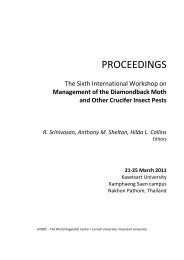Leguminous Vegetable Cultivation and Seed Production S ...
Leguminous Vegetable Cultivation and Seed Production S ...
Leguminous Vegetable Cultivation and Seed Production S ...
You also want an ePaper? Increase the reach of your titles
YUMPU automatically turns print PDFs into web optimized ePapers that Google loves.
Early varieties can be sown from mid-October to the first week of November while midseason<br />
varieties can be sown from the last week of October to mid-November. Late varieties can be<br />
sown up to the end of November.<br />
<strong>Seed</strong> Rate:<br />
Use 70 to 75 kg/ha for late varieties <strong>and</strong> 100 kg/ha for early varieties. For the variety Arkel<br />
the seed rate can be increased up to 125 kg/ha.<br />
Inoculation:<br />
Inoculation of pea seeds with pea nodule bacterium culture is recommended when peas are<br />
planted for the first time <strong>and</strong> also when the crop is to be grown on poor soil. Emulsify the culture<br />
material in a small quantity of 10 % sugar or gur solution, sufficient to moisten the seed. Heap the<br />
seed on a clean floor <strong>and</strong> moisten <strong>and</strong> mix thoroughly with the solution. Then spread moistened<br />
seed in a thin layer in the shade to dry <strong>and</strong> sow in the field in the evening or on a cloudy day.<br />
Spacing:<br />
Use 30 cm for row-to-row spacing for early <strong>and</strong> 45 cm for mid-season <strong>and</strong> late varieties.<br />
Within-row continuous sowing is done <strong>and</strong> later on the plants can be spaced at adistanoe of 2 to<br />
ljozo.l1labor is cheap <strong>and</strong> adequate then sowing with odibbler with spikes at 3"x7" distance is<br />
preferred.<br />
Fertilizer Use:<br />
A high dose of nitrogenous fertilizer may have a deleterious effect on nodule formation <strong>and</strong><br />
nitrogen fixation. A small dose of nitrogenous fertilizer ( about 25 N/ha ) is necessary to stimulate<br />
early growth ,of legumes. Phosphates increase yield <strong>and</strong> improve the quality of peas, whereas<br />
potassium appears to increase the yield <strong>and</strong> nitrogen fixation ability of the legumes. Apply about<br />
20 t FYM/ha, 125 kg CAN/ha or 60-65 kg urea/ha, 420 kg Superphosphate/ha, <strong>and</strong> 100 kg to<br />
100 kg Murate of Potash /ha during field preparation.<br />
Irrigation:<br />
For proper germination presoaking is advisable. If the soil moisture is less at the time of<br />
sowing, a light irrigation may be necessary after planting to ensure proper germination. Thereafter,<br />
during the dry period, light irrigation may be given at an interval of 10-15 days. One or two<br />
irrigations at the time of flowering <strong>and</strong> fruit-setting are essential. Light irrigation during frosty<br />
weather is also essential to protect the developing flowers <strong>and</strong> pods from frost damage. Irrigation<br />
with sprinkler is very much recommended.<br />
Isolation:<br />
Since garden pea is a self-pollinated crop, not much contamination is expected in producing<br />
pure seeds of a variety. Consequently the only isolation necessary is to have a planting space far<br />
enough to prevent mechanical mixtures at planting or harvesting time. However, when producing<br />
the foundation seed, two different varieties should be kept about 20 m.<br />
Roguing:<br />
The term "rogue" as used today applies to any off-type plant. Rogues may originate as a<br />
result of mechanical mixture, volunteer mixture from earlier plantings, natural crossing or<br />
morphological changes caused by mutations.<br />
2
















